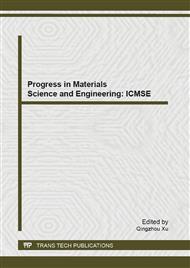[1]
U. Beste, T. Hartzell, H. Engqvist, and N. Axén, Surface Damage on Cemented Carbide Rock-drill buttons, Wear. Vol. 249(2001), p.324.
DOI: 10.1016/s0043-1648(01)00553-1
Google Scholar
[2]
Y. Torres, M. Anglada, and L. Llanes, Fatigue Mechanics of WC-Co Cemented Carbides, Int. J. Refract. Met. Hard Mater. Vol. 19(2001), p.341.
DOI: 10.1016/s0263-4368(01)00032-4
Google Scholar
[3]
S. Okamoto, Y. Nakazono, K. Otsuka, Y. Shimoitani, and J. Takada, Mechanical Properties of WC-Co Cemented Carbide with Larger WC Grain Size. Mater. Charact. Vol. 55(2005), p.281.
DOI: 10.1016/j.matchar.2005.06.001
Google Scholar
[4]
S.Q. Li, Y. Huang, C.A. Wang, Z.P. Xing, and Z.D. Guan, R-curve Behavior for Si3N4/BN Fibrous Monolithic Ceramic. J. Mater. Eng. Vol. 1(2001), p.7.
Google Scholar
[5]
H. Guo, Y. Huang, C.A. Wang, and J.B. Li, Properties and Structure of In-situ Fibrous Si3N4 Monolithic Ceramic. J. Chin. Cera. Soc. Vol. 1(1998), No. 26, p.20.
Google Scholar
[6]
G. Hilmas, A. Brady, U. Abdali, G. Zywicki, and J. Halloran, Fibrous Monoliths:Non-Brittle Fracture from Powder Processed Ceramics. Mater. Sci. Eng. A, Vol. 195(1995), p.263.
DOI: 10.1016/0921-5093(94)06525-x
Google Scholar
[7]
S.Q. Li, Y. Huang, C.A. Wang, Z.P. Xing, and Z.D. Guan, Creep Behavior of SiC Whisker-Reinforced Si3N4/BN Fibrous Monolithic Ceramics. J. Euro. Cera. Soc. Vol. 21(2001), p.841.
DOI: 10.1016/s0955-2219(00)00251-x
Google Scholar
[8]
S.Q. Li, Y. Huang, Q.F. Zan, and C.W. Li, The Flexural Strength of the Si3N4/BN Fibrous Monolithic Ceramic at Elevated Temperature by In-situ Synthesizing. China Ceramics, Vol. 5 (2001), 37, p.9.
Google Scholar
[9]
A. Griffo and D. Belnap. Improving Performance of Polycrystalline Diamond Components in Three-cone Roller Bits Using Fibrous Monolith Technology. Ceram. Eng. Sci. Proc. No. 25(2004), p.211.
DOI: 10.1002/9780470291191.ch33
Google Scholar
[10]
S.E. Landwehr, G. Hilmas, B. White, A. Groggo, and J. Bitler, Wear characteristics of Functionally Designed Cellular Cemented Carbides Produced by Co-extrusion. Int. J. Refract. Met. Hard. Mater. Vol. 25(2007), p.199.
DOI: 10.1016/j.ijrmhm.2006.04.009
Google Scholar
[11]
J. Watts, and G. Hilmas, Processing and Indentation Bahavior of Functionally Designed Cellular Cemented Carbides Produced by Coextrusion. Int. J. Refract. Met. Hard. Mater. Vol. 24(2006), p.229.
DOI: 10.1016/j.ijrmhm.2005.04.019
Google Scholar


